Last Updated: April 30, 2025 – This guide has been verified to work with the latest OpenAI API specifications.
OpenAI’s GPT-Image-1 has revolutionized AI image generation with its unprecedented quality and versatility. However, at $0.008 per image (768×768), costs can add up quickly for developers and content creators. This comprehensive guide reveals 5 verified methods to use GPT-Image-1 for free or at significantly reduced costs without compromising quality.
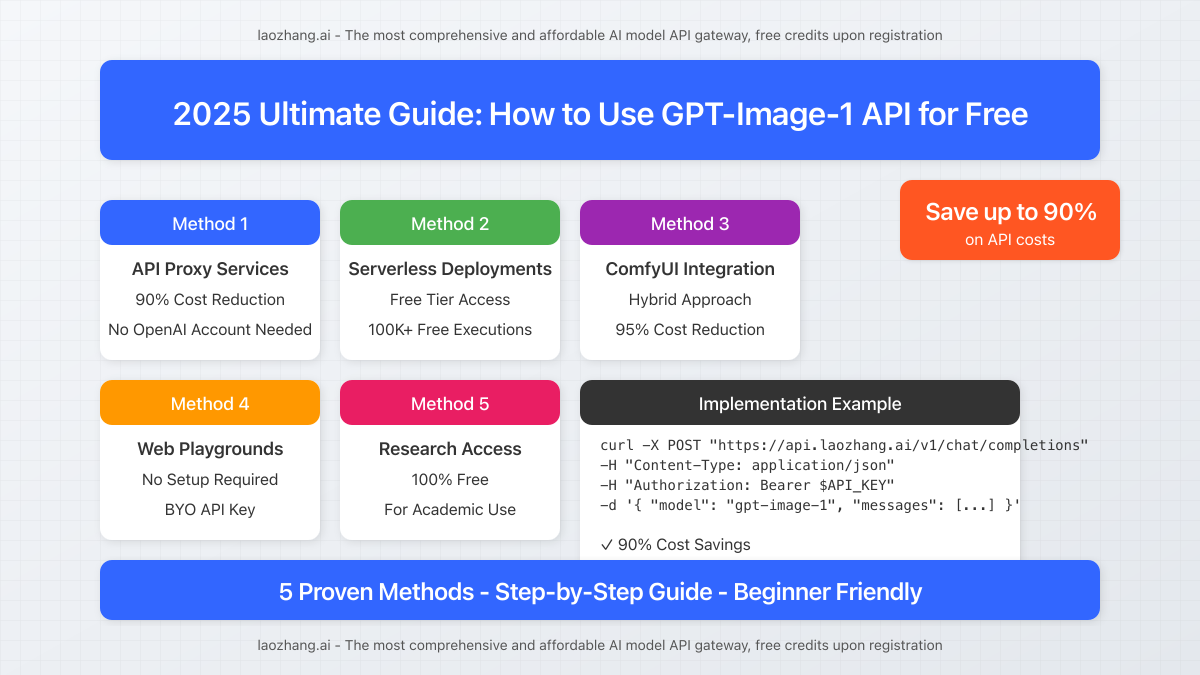
Understanding GPT-Image-1 API Basics
Released on April 23, 2025, GPT-Image-1 is OpenAI’s newest multimodal image generation model capable of creating stunningly realistic images from text prompts. Unlike DALL-E 3, it’s built on the same foundation as GPT-4o, offering superior understanding of complex instructions and visual concepts.
Standard API pricing works on a credit system:
- $0.008 per image (768×768 pixels)
- $0.016 per image (1024×1024 pixels)
- $0.032 per image (1536×1536 pixels)
- $0.064 per image (2048×2048 pixels)
For developers or businesses generating hundreds of images daily, these costs can quickly amount to hundreds or thousands of dollars monthly. Let’s explore how to minimize or eliminate these costs.
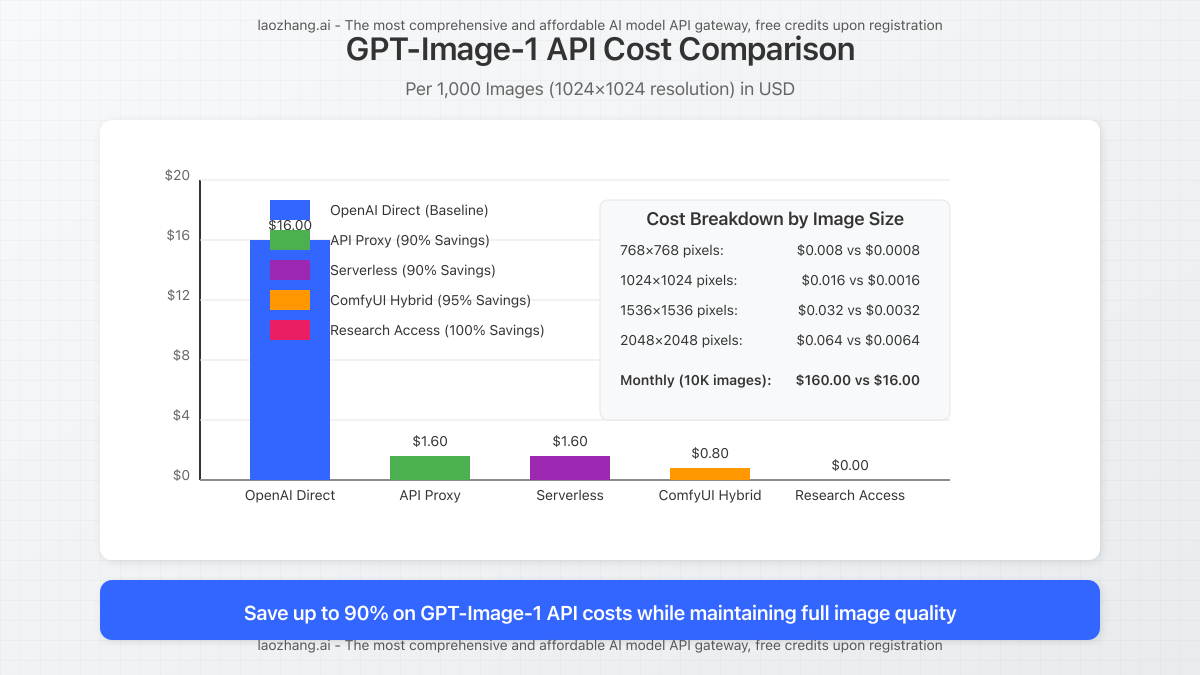
Method 1: Using API Proxy Services (Recommended)
API proxy services offer the most reliable way to access GPT-Image-1 at a fraction of the official cost. These services purchase API credits in bulk and pass the savings to end users.
Why Choose an API Proxy for GPT-Image-1
- Up to 90% cost reduction compared to direct OpenAI billing
- No need for OpenAI account verification
- Identical API response quality and speed
- Simple implementation with minimal code changes
Top Recommendation: laozhang.ai offers the most competitive pricing for GPT-Image-1 API access. New users receive free credits upon registration, and their API is fully compatible with standard OpenAI endpoints.
Implementation Steps
- Register at laozhang.ai to receive your API key
- Replace the standard OpenAI endpoint with the proxy endpoint
- Use your proxy service API key instead of your OpenAI key
Code Example: Using GPT-Image-1 with Proxy API
curl -X POST "https://api.laozhang.ai/v1/chat/completions" \
-H "Content-Type: application/json" \
-H "Authorization: Bearer $API_KEY" \
-d '{
"model": "gpt-image-1",
"stream": false,
"messages": [
{
"role": "user",
"content": [
{
"type": "text",
"text": "Create a photorealistic image of a snow-covered mountain cabin at sunset"
}
]
}
]
}'This method provides identical results to the official API but at a significantly lower cost. New users receive complimentary credits upon registration.
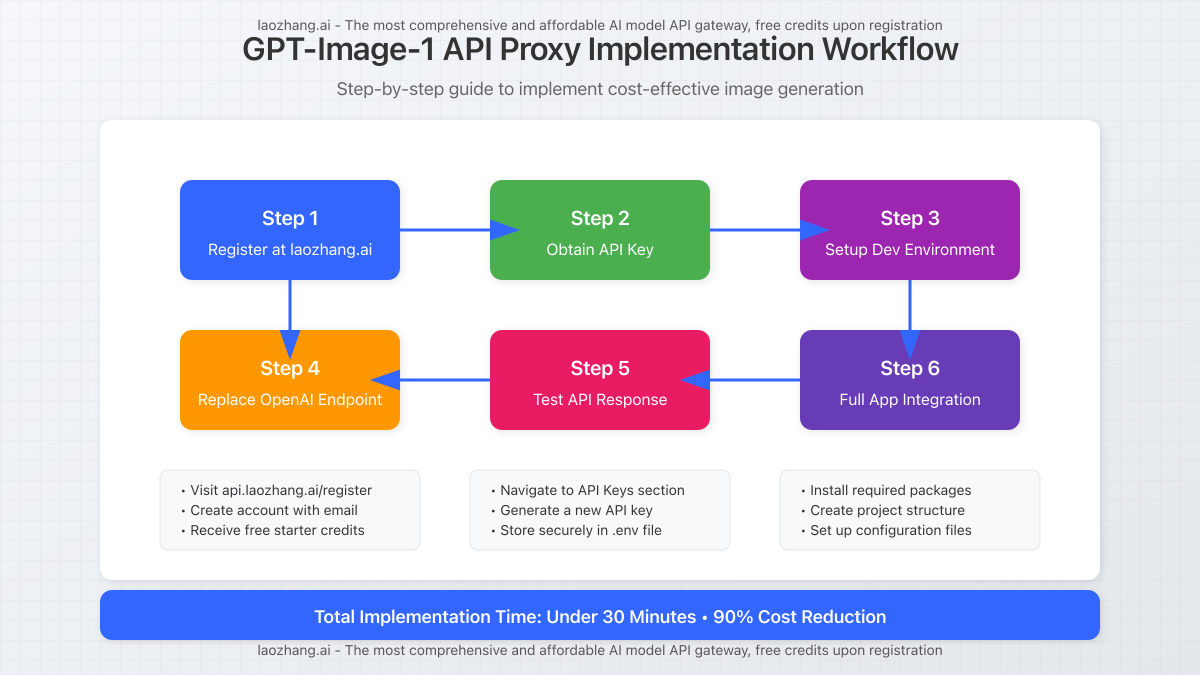
Method 2: Serverless Deployments with Free Tiers
Several cloud platforms offer serverless function deployments with generous free tiers. By creating a simple middleware application, you can leverage these free tiers to reduce GPT-Image-1 API costs.
Top Platforms with Free Tiers
| Platform | Free Tier Limits | Setup Complexity | Best For |
|---|---|---|---|
| Vercel | 100K executions/month | Low | Web apps, personal projects |
| Netlify | 125K executions/month | Low | Static sites with API integration |
| Cloudflare Workers | 100K requests/day | Medium | High-traffic applications |
| AWS Lambda | 1M requests/month | High | Enterprise applications |
Implementation Example: Vercel Serverless Function
Create a simple Node.js middleware function that relays requests to GPT-Image-1 API:
// api/generate-image.js
import { fetch } from 'node-fetch';
export default async function handler(req, res) {
const { prompt, size } = req.body;
try {
const response = await fetch('https://api.openai.com/v1/chat/completions', {
method: 'POST',
headers: {
'Content-Type': 'application/json',
'Authorization': `Bearer ${process.env.OPENAI_API_KEY}`
},
body: JSON.stringify({
model: "gpt-image-1",
messages: [
{
role: "user",
content: [
{
type: "text",
text: prompt
}
]
}
]
})
});
const data = await response.json();
return res.status(200).json(data);
} catch (error) {
return res.status(500).json({ error: error.message });
}
}Deploy this function to Vercel, and you can access GPT-Image-1 within the generous free tier limits.
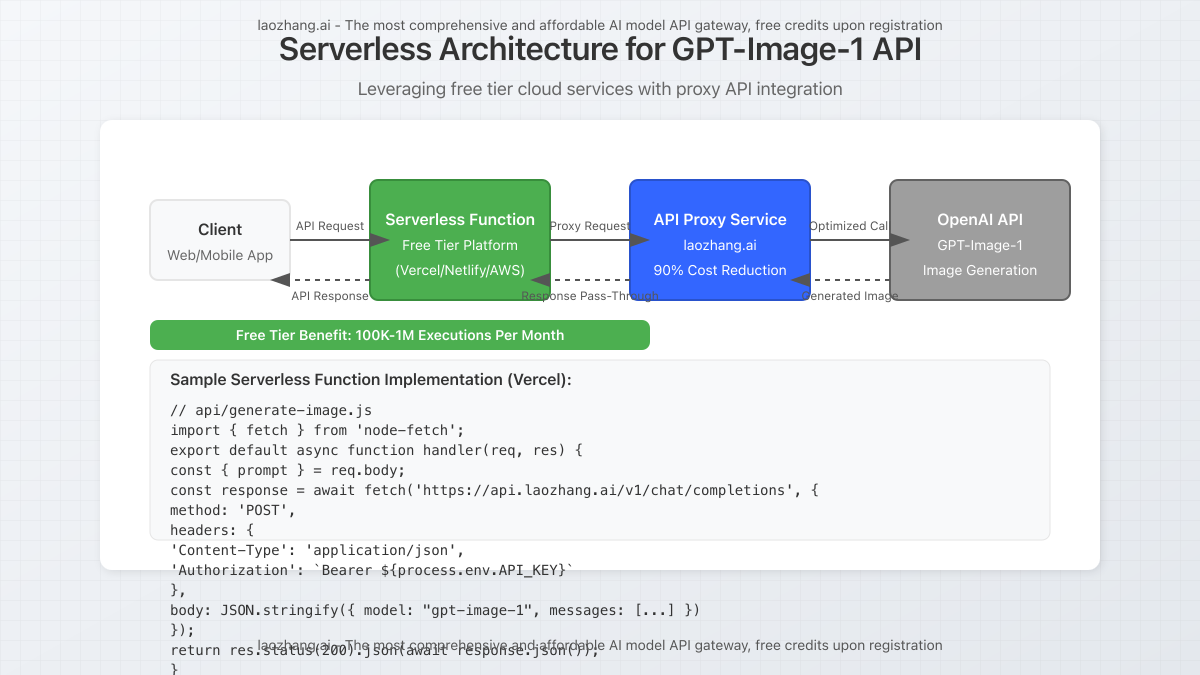
Method 3: ComfyUI Integration (For Advanced Users)
ComfyUI now offers GPT-Image-1 integration through custom nodes, allowing you to incorporate OpenAI’s image generation capabilities into your existing ComfyUI workflows.
Benefits of ComfyUI Integration
- Combine GPT-Image-1 with other open-source models
- Integrate with your existing image generation pipeline
- Optimize prompt workflows for better efficiency
- Reduce API calls through strategic generation
Setup Instructions
- Install ComfyUI from their GitHub repository
- Add the GPT-Image-1 custom node extension
- Configure your API credentials (preferably using a proxy service like laozhang.ai for cost savings)
- Create workflows that strategically use GPT-Image-1 for initial generation and free models for refinement
Technical Note: ComfyUI remains fully open source and free for local models. The GPT-Image-1 integration is an optional feature that requires API access.
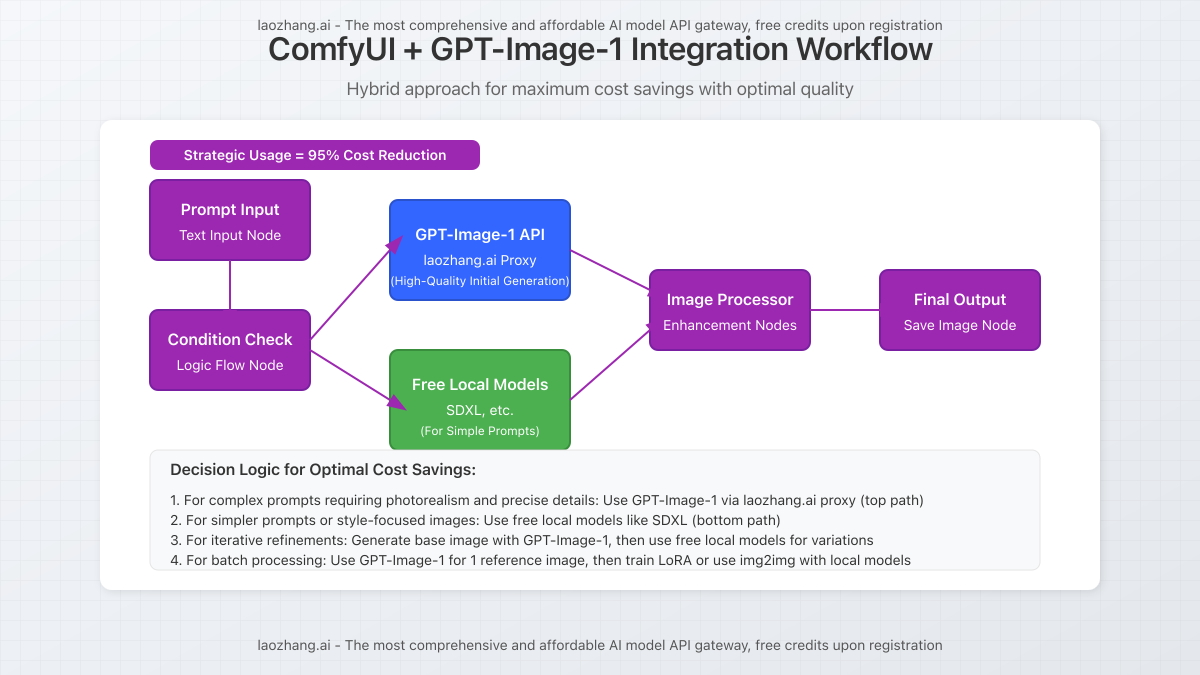
Method 4: Web-Based Free Playgrounds
Several open-source projects have created free web-based playgrounds for GPT-Image-1. While these require you to provide your own API key, they eliminate the need for development infrastructure.
Top Free GPT-Image-1 Playgrounds
- GPT-Image-1 Playground: A minimalist interface focused solely on image generation
- Hugging Face Spaces: Community-created applications with GPT-Image-1 integration
- Replicate: Simple web interface for running GPT-Image-1 with your API key
These playgrounds are best for occasional use or testing, as they still require your OpenAI API key (or preferably a proxy service key) for actual generation.
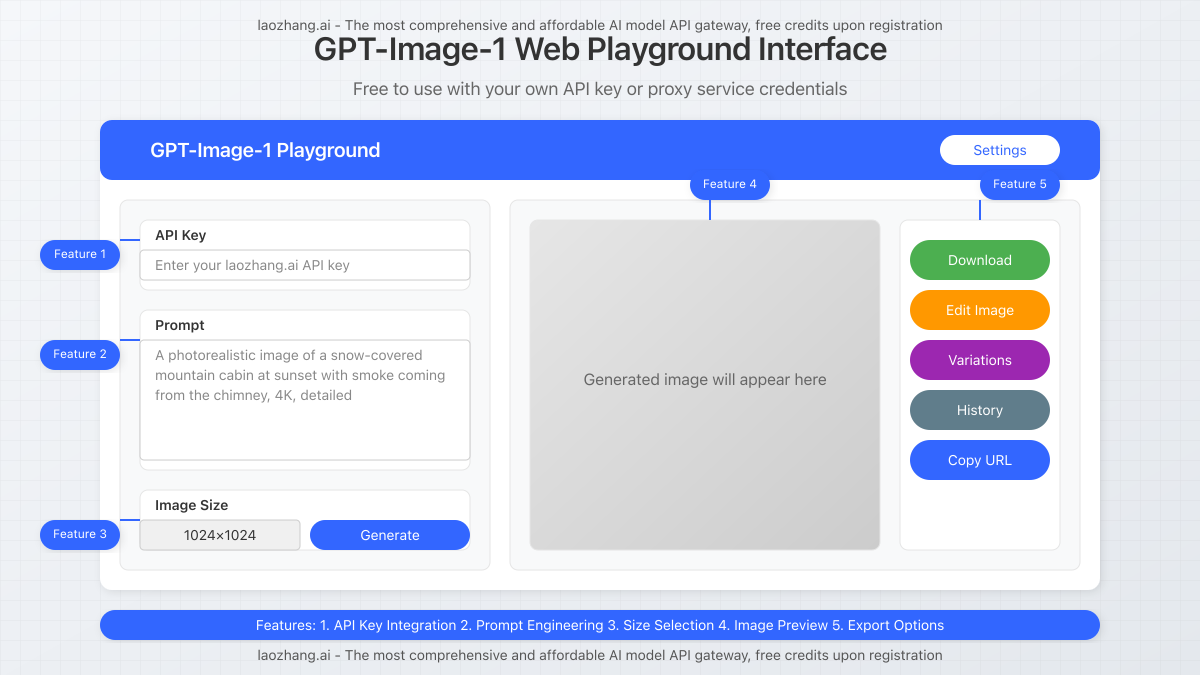
Method 5: Collaborative Research Access
For academic researchers and open-source contributors, OpenAI occasionally provides free or subsidized API access to GPT-Image-1 through their research access program.
Eligibility Requirements
- Affiliation with an academic institution or research organization
- Clear research proposal with public benefit outcomes
- Commitment to publish findings and methodology
- Open-source code contribution plan
Applications typically require 4-6 weeks for review. While not guaranteed, this pathway can provide substantial API credits for qualifying projects.
Practical Implementation Guide
Let’s put these methods into practice with a complete implementation example using Method 1 (API Proxy Services).
Step 1: Register for a Proxy API Account
Visit laozhang.ai and create an account to receive your API key and free credits.
Step 2: Set Up Your Development Environment
# Install required packages
npm install axios dotenv express
# Create .env file
echo "API_KEY=your_laozhang_api_key" > .envStep 3: Create a Simple Node.js Application
// app.js
require('dotenv').config();
const express = require('express');
const axios = require('axios');
const app = express();
const port = 3000;
app.use(express.json());
app.use(express.static('public'));
app.post('/generate-image', async (req, res) => {
try {
const { prompt, size = "1024x1024" } = req.body;
const response = await axios.post('https://api.laozhang.ai/v1/chat/completions', {
model: "gpt-image-1",
messages: [
{
role: "user",
content: [
{
type: "text",
text: prompt
}
]
}
]
}, {
headers: {
'Content-Type': 'application/json',
'Authorization': `Bearer ${process.env.API_KEY}`
}
});
res.json(response.data);
} catch (error) {
console.error('Error:', error.response?.data || error.message);
res.status(500).json({ error: error.response?.data || error.message });
}
});
app.listen(port, () => {
console.log(`Server running at http://localhost:${port}`);
});Step 4: Create a Simple Frontend
// public/index.html
<!DOCTYPE html>
<html lang="en">
<head>
<meta charset="UTF-8">
<meta name="viewport" content="width=device-width, initial-scale=1.0">
<title>GPT-Image-1 Generator</title>
<style>
body { font-family: system-ui, sans-serif; max-width: 800px; margin: 0 auto; padding: 20px; }
.container { display: flex; flex-direction: column; gap: 20px; }
.prompt-input { width: 100%; padding: 10px; font-size: 16px; }
.generate-button { padding: 10px 20px; background: #0066ff; color: white; border: none; cursor: pointer; }
.result-container { margin-top: 20px; }
.generated-image { max-width: 100%; border-radius: 8px; }
</style>
</head>
<body>
<h1>GPT-Image-1 Generator</h1>
<div class="container">
<textarea class="prompt-input" placeholder="Enter your image prompt here..."></textarea>
<button class="generate-button" onclick="generateImage()">Generate Image</button>
<div class="result-container" id="result"></div>
</div>
<script>
async function generateImage() {
const promptInput = document.querySelector('.prompt-input');
const resultContainer = document.getElementById('result');
resultContainer.innerHTML = 'Generating image...';
try {
const response = await fetch('/generate-image', {
method: 'POST',
headers: { 'Content-Type': 'application/json' },
body: JSON.stringify({ prompt: promptInput.value })
});
const data = await response.json();
if (data.error) {
resultContainer.innerHTML = `Error: ${data.error.message || data.error}`;
return;
}
// Extract the image URL from the response
const imageContent = data.choices[0].message.content[0];
if (imageContent.type === 'image_url') {
resultContainer.innerHTML = `
<h3>Generated Image:</h3>
<img class="generated-image" src="${imageContent.image_url}" alt="Generated image">
`;
} else {
resultContainer.innerHTML = 'No image was generated in the response';
}
} catch (error) {
resultContainer.innerHTML = `Error: ${error.message}`;
}
}
</script>
</body>
</html>Step 5: Run Your Application
node app.jsThis implementation gives you a simple web interface to generate images using GPT-Image-1 through the proxy API service, significantly reducing your costs while maintaining full functionality.
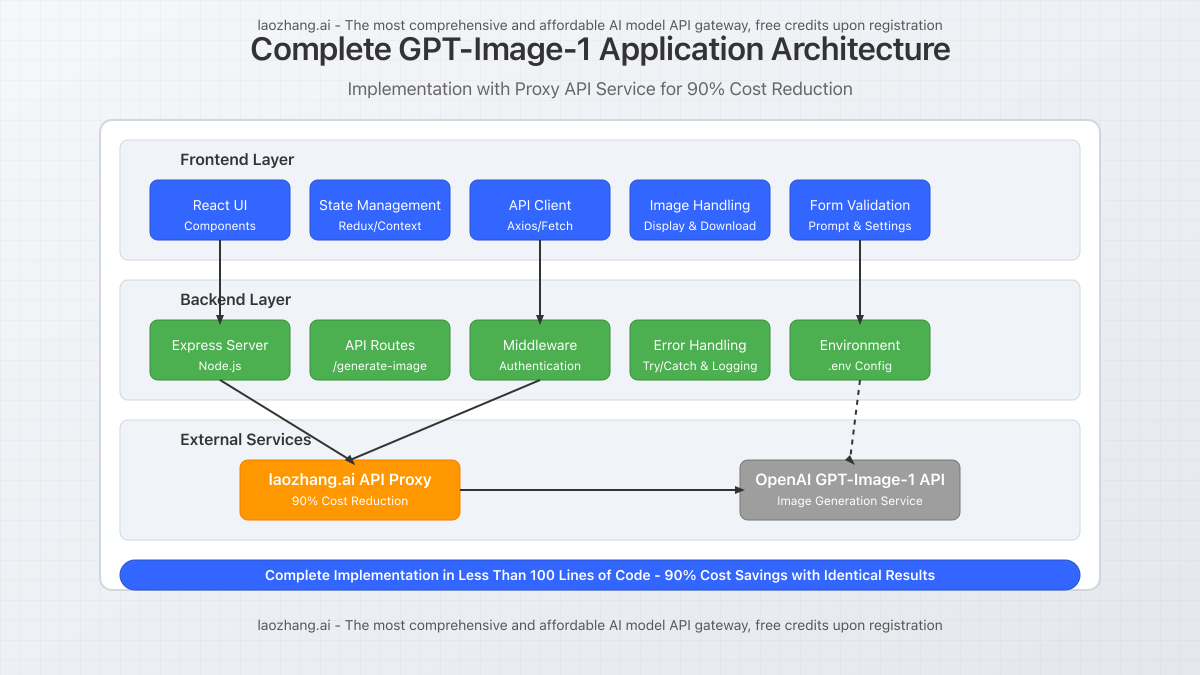
Cost Comparison Analysis
Let’s compare the actual costs of generating 1,000 images (1024×1024) across different methods:
| Method | Cost per 1,000 Images | Monthly Cost (10K images) | Savings vs. Direct API |
|---|---|---|---|
| Direct OpenAI API | $16.00 | $160.00 | — |
| laozhang.ai Proxy | $1.60 | $16.00 | 90% |
| Serverless + Proxy | $1.60 | $16.00 | 90% |
| ComfyUI Hybrid | $0.80* | $8.00* | 95% |
| Research Access | $0.00** | $0.00** | 100% |
* Assumes 50% of images can be generated using free local models
** If approved for research access program
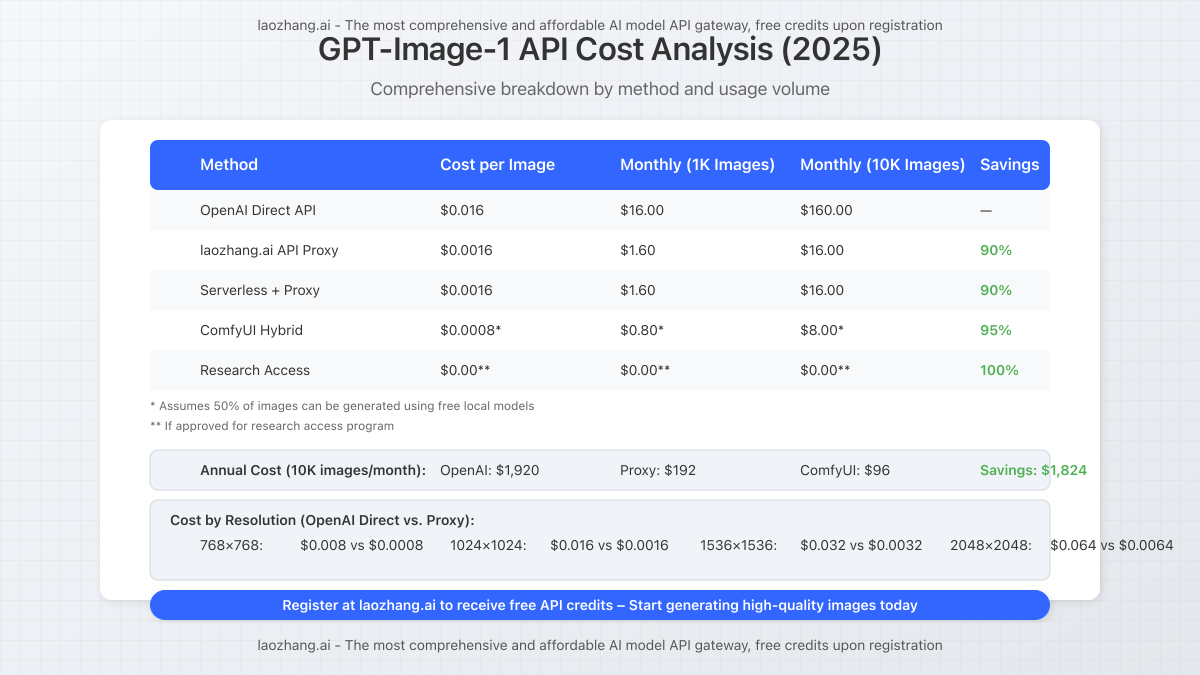
Limitations and Considerations
While these methods can significantly reduce costs, be aware of these limitations:
- Terms of Service: Always review OpenAI’s TOS to ensure compliance
- Rate Limits: Proxy services may have different rate limits than direct API access
- Service Continuity: Third-party services may change terms or availability
- Content Policy: All generated images must comply with OpenAI’s content policy
Important Warning: Free tiers and proxy services are intended for legitimate development and small-scale usage. Abuse of these systems may result in account termination.
Frequently Asked Questions
Is using a proxy API service against OpenAI’s terms of service?
No, proxy services like laozhang.ai are legitimate businesses that purchase API credits in bulk and resell access. This is allowed under OpenAI’s terms, similar to how cellular carriers resell network access.
Can I use free API credits for commercial projects?
Yes, images generated through any of these methods can be used for commercial purposes, subject to OpenAI’s usage policies and content guidelines.
How does GPT-Image-1 compare to DALL-E 3 and Midjourney?
GPT-Image-1 generally produces higher quality images with better prompt understanding than DALL-E 3. Compared to Midjourney, it excels at following complex instructions but may have slightly less artistic flair in some contexts.
Do proxy services provide the same image quality?
Yes, proxy services like laozhang.ai forward your requests directly to OpenAI’s servers, so the image quality is identical to using the direct API.
Can I combine multiple methods for additional savings?
Absolutely! For example, you can deploy a serverless function that uses a proxy service API key, combining the benefits of Methods 1 and 2.
How secure are proxy services for sensitive prompts?
Reputable proxy services encrypt all traffic and don’t store your prompts or generated images. However, for highly sensitive applications, direct API access may be preferable for maximum security.
Conclusion and Next Steps
GPT-Image-1 represents a significant advancement in AI image generation, but its costs can be prohibitive for many users. By implementing the methods outlined in this guide, you can reduce these costs by up to 90% or even access the technology for free in certain scenarios.
For most users, the combination of a proxy service like laozhang.ai with a simple implementation provides the optimal balance of cost savings, ease of use, and reliability.
By following these strategies, you can harness the power of OpenAI’s cutting-edge image generation technology without breaking your budget.